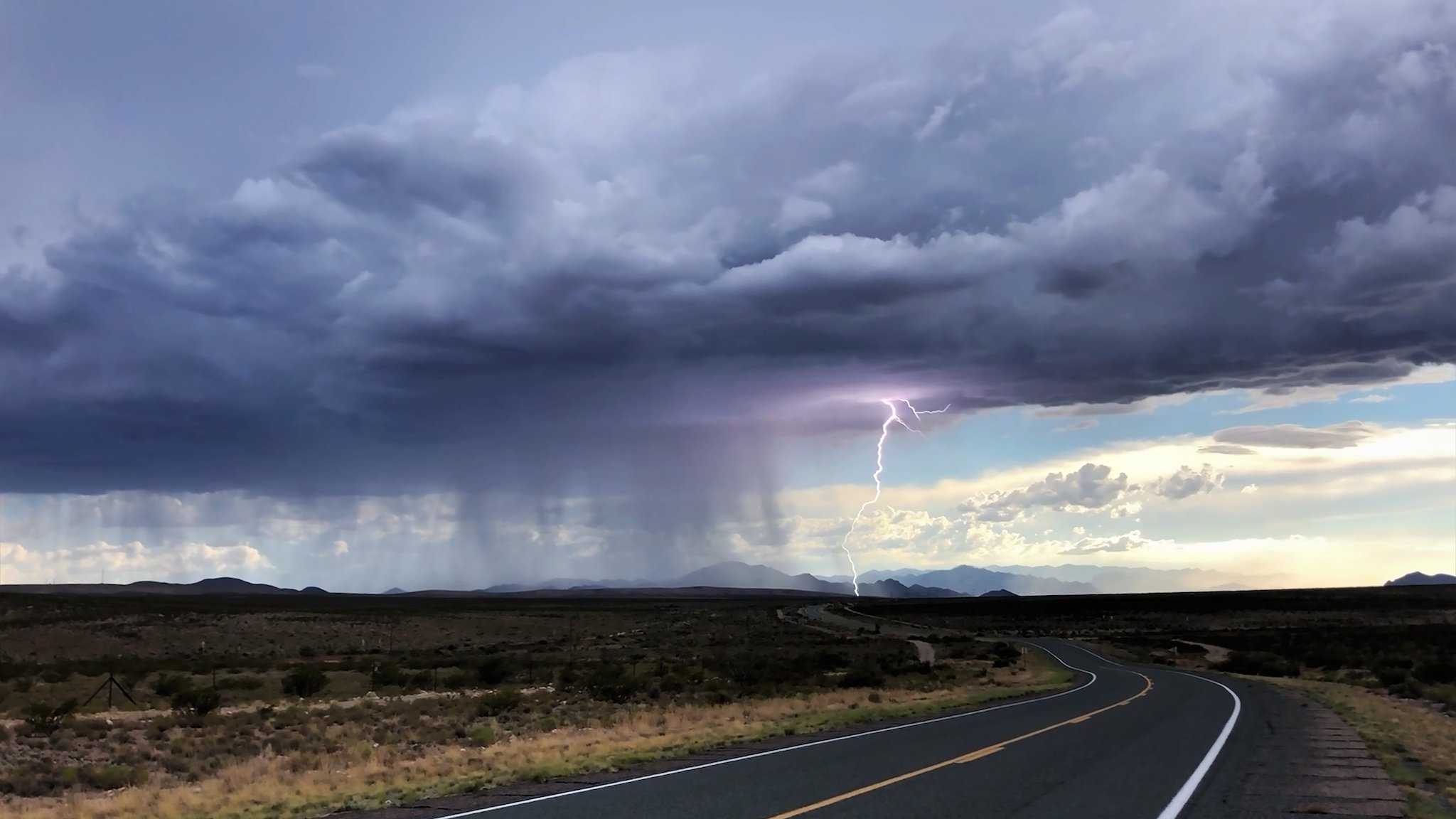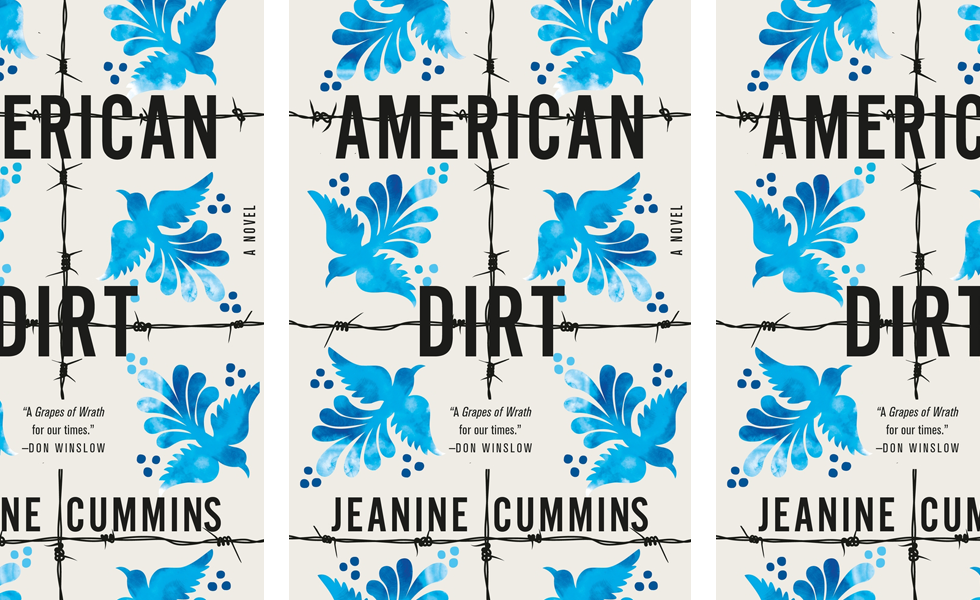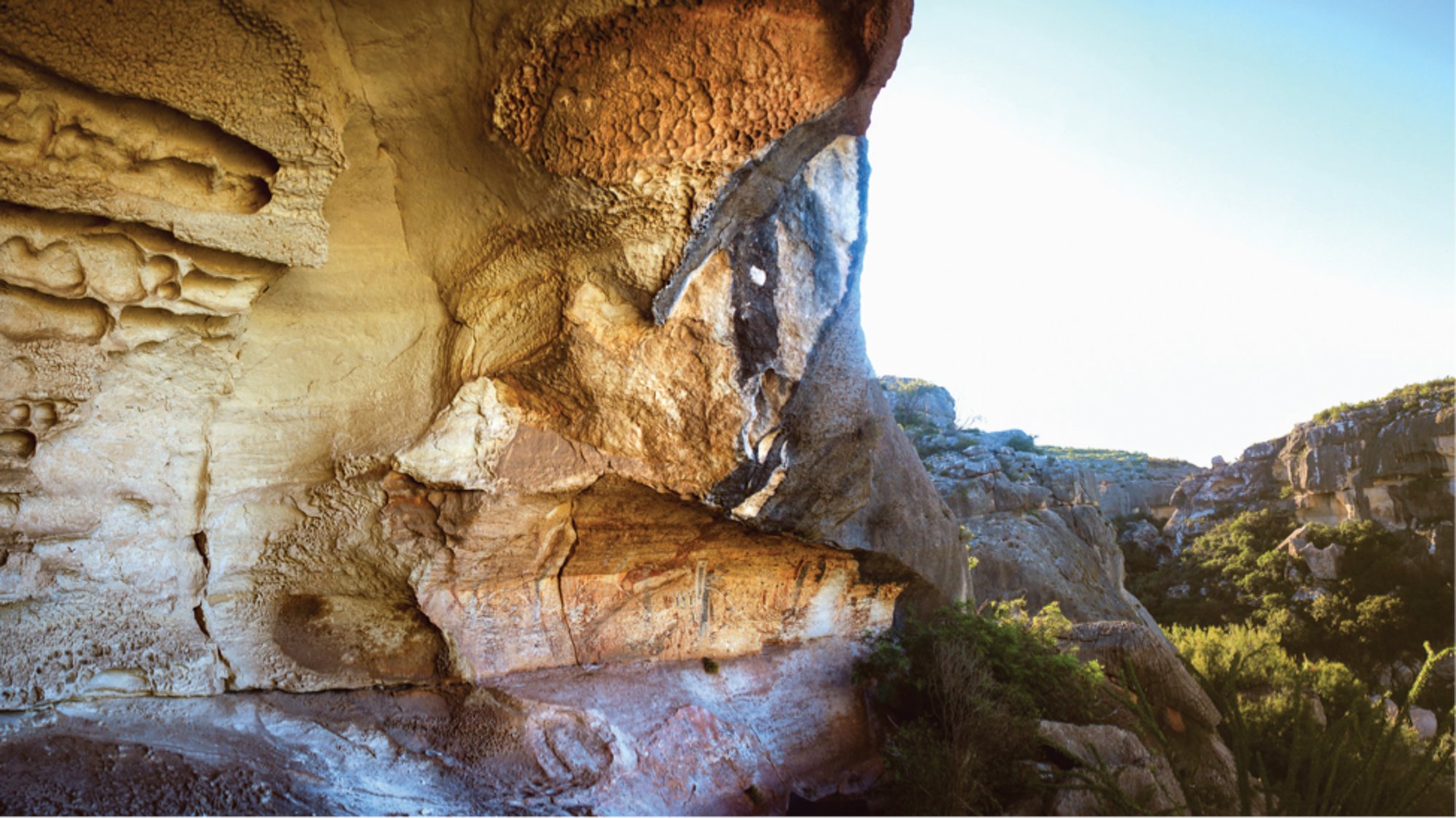
If These Walls Could Talk
The pictographs of the Pecos River have lasted millennia in a tempestuous desert, surviving mostly in silence. Now an archaeologist has cracked the code — and they can begin to speak again.

A version of this story ran in the December 2016 issue.
The pictographs of the Pecos River have lasted millennia in a tempestuous desert, surviving mostly in silence. Now an archaeologist has cracked the code — and they can begin to speak again.
–
by Brad Tyer
December 2, 2016
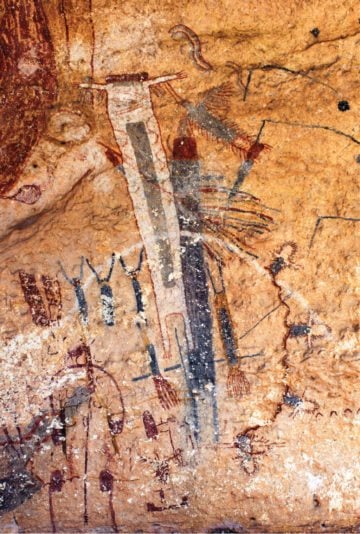
September 12, 2012, was a long day, but a good one. For Carolyn Boyd it started with a 30-minute drive from her home in Comstock to a 265-acre preserve, where she convened with fellow archaeologists Mark Willis and Amanda Castaneda and left the road behind. From there it was a half-hour walk on a well-worn trail traversing cactus-strewn stone. The ladder they carried made for awkward hiking, but the cool fall morning helped compensate. By 8:30 a.m. they had climbed down from the scrubby plateau and arrived at a shallow, mouth-shaped indentation near the top of a rough cliff overlooking the Pecos River. Just downstream, occasional cars and semis hummed across the 1,310-foot bridge that carries U.S. Highway 90 over the river, almost 300 feet below. A little more than a mile downstream, the Pecos slipped quietly into the Rio Grande.
The mouth-shaped indentation was well known, the site of an elaborate expanse of prehistoric painted rock art known as the White Shaman mural, after its spectral central figure. Boyd had been to the shelter maybe a hundred times, but this was the first time she had come equipped with a $500 Dino-Lite digital microscope.
The White Shaman mural is painted in four colors — red, black, yellow and white, often overlapping or interwoven — and Boyd wanted to know in which order the paints had been applied. The Dino-Lite, more commonly deployed in medical and industrial applications, was Willis’ idea. Using the handheld microphone-size capsule, Boyd could examine the margins between pigments at the microscopic level, and simultaneously take high-resolution photographs to examine back in the lab.
As Boyd moved methodically across the wall, Willis — watching the images on a laptop connected to the Dino-Lite via USB cable — called out what the screen was showing him: “red over black; red over black; yellow over red; yellow over black; white over yellow.”
Boyd realized she was hearing a pattern.
“It was clear as a bell,” she remembers. “The red was over the black. … Everywhere in the entire mural, we found that black was the bottom layer.”
Boyd trained the Dino-Lite on the figure of a deer whose red antlers were decorated with black dots. Sure enough, the black dots had been applied to the wall first. The red antlers had been painted around the dots. “That made just no sense to me at all as an artist,” Boyd says. “I would paint the red body of the deer and then I would paint the black dots. So what in the world would they do it the other way for? … That says that everything carried meaning. Not just the symbols that go on the wall, or the relationship of one symbol to another, not just the color of the symbol — even the order of the paint carries meaning.”
The archaeologists logged 656 microscopic images of 42 locations on the White Shaman mural that day, and another 1,635 macro photos. The images would be examined later, in the lab, subject to double- and sometimes triple-blind confirmation on big, bright screens, far from the dust and glare of the rock shelter. But Boyd already had a sense of what she’d found.
“I can remember going home at the end of the day,” she says. “And I was standing at my kitchen island and it hit me, just overwhelmed me. Everything that had happened that day sank in, and I realized at that moment that this was a discovery that changed everything.”
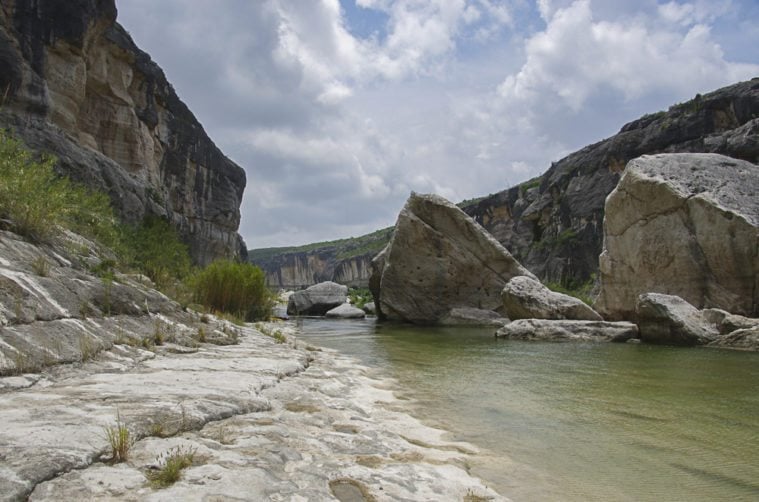
The first time Boyd saw the White Shaman, she saw it with an artist’s eyes. Boyd was 30 at the time, a successful fine-art muralist with a gallery in north Houston and a project of painting artists — musicians, weavers, potters — at work. “I felt that there was something really powerful that an artist was able to communicate through this act of creation,” she says.
That project led to an interest in North America’s earliest art. A friend told her she had to see the rock art of the Pecos, and they drove west, lucked into a park ranger who helped them access the White Shaman site, and found themselves face to face with a voice from the past.
“They had a language far richer than our own when it comes to describing the stars and the landscape around them. … Same brain that put a man on the moon. They were just as cognitively capable as you and I.”
“As soon as I saw it I recognized how complex these murals were,” Boyd says. “I was working as a muralist, so I understood what it would require to paint something of that magnitude. It’s pretty stunning. Especially given the circumstances. The floors of these shelters are not level. Imagine the challenge of producing scaffolding in that kind of environment, and the planning it would have required. I was just in awe of the people who produced them, and just wanted to know more.”
Boyd wasn’t aware at the time of the archaeological consensus that the White Shaman mural, and Pecos River rock art generally, is essentially incomprehensible — random collections of images accreted over the course of hundreds or thousands of years, perhaps shamanistic in nature, a record of hallucinatory visions, or maybe just the leisure-time doodles of a people lost to history. An intriguing source for speculation, certainly, but not artistic compositions in any contemporary sense.
“I think it really helped me to come at it as an artist, as opposed to an archaeologist,” Boyd says, “because I hadn’t been taught yet that you will never know what it means, that there is no order to this.” Boyd’s insight was revelatory, but she lacked the tools to prove or communicate it. So in 1991 she enrolled at Texas A&M and spent the next seven years acquiring degrees in anthropology and archaeology. In 1998, with her doctorate freshly minted, Boyd founded the nonprofit Shumla School — now the Shumla Archaeological Research and Education Center — which has grown to five buildings in Comstock and a field office on 70 donated acres a few miles west of the White Shaman site.
In 2003, Texas A&M University Press published her first book, Rock Art of the Lower Pecos, which began to build the case for Pecos rock art as a coherent and interpretable cultural expression — a story, in essence, that might be read, if only anyone knew its language.
The Pecos River of 2,000 years ago, when the White Shaman mural is thought to have been painted, looked much like the Pecos River of today. Its course marks a transitional zone between the Edwards Plateau, which defines the Texas Hill Country, and the Chihuahuan Desert, which extends southwesterly through Big Bend into northern Mexico. Plateaus are sparsely vegetated with cactus, mesquite, lechuguilla and ocotillo. (Though there were significantly richer grasses in the uplands before ranchers began grazing cattle in the late 1800s.) Three rivers water the region archaeologists call the Lower Pecos Canyonlands: the Rio Grande, the Pecos and the Devils, the latter two largely contained by limestone canyons pocked with ledges and shallow caves. Springs percolate through the porous limestone, feeding the rivers during drought. Then, as now, flash floods scour the channels with unpredictable regularity.
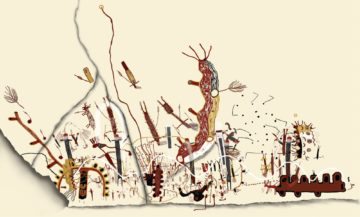
paint were applied to the shelter wall first, followed by five layers of red paint. Courtesy UT Press
Today, the Lower Pecos Canyonlands are seen by few people other than intrepid canoeists, laborers working the large ranches abutting the river, or a very few trophy-home owners with penchants for solitude.
But thousands of years ago, the landscape was home to small bands of hunter-gatherers of indeterminate origin. Not much is known about them, but quite a bit is inferred.
There were bison in the Trans-Pecos back then, and a site called the Bonfire Shelter holds the mounded skeletal remains of hundreds of them. These bones are evidence of a bison jump, a hunting technique characteristic of northern Plains people, whereby bison were herded over a cliff en masse and crashed to their deaths in a pile.
The people of the Pecos also hunted deer and rabbits and rodents, using atlatls to throw stone arrow points. They almost certainly caught and ate fish. They went to a good deal of trouble — lots of pounding and steaming and roasting — to make a digestible meal out of almost indigestible lechuguilla hearts.
They left behind tools fashioned from bone, carrying pouches made from prickly pear pads, flutes carved from cane, sandals and mats woven from plant fiber, and carved wooden digging sticks and darts. They decorated small pebbles that they apparently carried from place to place.
They don’t have a name. Their culture is considered prehistoric because there is no contemporaneous written account of it — even though the global historic era, marked by the invention of writing 5,200 years ago in Sumer, predates them. The earliest recognized dates of their tenure in the Trans-Pecos coincide roughly with the construction of Stonehenge, 5,000 years ago, though there’s evidence of human habitation in the area stretching another 6,000 years beyond that.
“In native America, those images, as soon as they are applied to the wall, they are living. They are incarnated. We can’t even imagine what that would be like — to paint an image of something and give it life.”
Because it’s difficult to fathom five millennia in terms of a human lifespan, and because the Pecos then, as now, offers such notoriously slim pickings in terms of sustenance, a lot of people have a hard time imagining what sort of people, evolutionarily speaking, they might have been. Boyd has been asked if they communicated in grunts.
They didn’t. Language was already thousands of years old.
“[People] think of them as somehow being less than we are, intellectually,” Boyd says. “And it’s just not true. This rock art is clear evidence that it’s just not true. … They had a language far richer than our own when it comes to describing the stars and the landscape around them. … Same brain that put a man on the moon. They were just as cognitively capable as you and I. … At the end of the day, they are us.”
Boyd has thought about it, and she thinks she could reproduce the White Shaman mural, in situ, in about a week. But the time spent actually putting paint on rock is probably almost negligible compared to preparations.
First, you’d have to be intimately familiar with your rock shelter. The White Shaman mural shows evidence of alignment with solstice light and shadow. Minerals tinted black, white, red and yellow had to be collected and pulverized. Yucca juice, or something like it, had to be extracted for use as an emulsifier. The people had to build sturdy scaffolding from desert plants. Animal fat, one of their most important commodities, was diverted from their diets for use as a paint binder.
“You’re talking about a hunting and gathering group living in a desert environment where very little food that they have has the amount of fat that they need,” Boyd says. “So to take and use that animal fat was taking a very precious, life-giving source of nutrients away from the people, the entire group, to produce these paintings. It was a communal sacrifice to produce these.”
Unlike us, the mural’s creators did not view paintings as two-dimensional objects, Boyd says. “In native America, those images, as soon as they are applied to the wall, they are living,” she says. “They are incarnated. We can’t even imagine what that would be like — to paint an image of something and give it life.”
Once the prep was done, Boyd thinks, no more than a couple of artists probably completed the work in a few days. Not much evidence remains of how they applied paint to rock, just a few lechuguilla-fiber brushes, but Boyd, who has re-created the mural in mediums from pastel and colored pencil to Photoshop, has no trouble imagining the process.
“I’ve made the paint many times, and painted on a lot of rocks. You can use animal-hair brushes, feathers. They applied with their hands, and you can even see fingerprints in some,” she says. “You’ve got things where they sprayed it maybe through a tube, so you can do that negative-space kind of thing where you put a hand and then you spray around it.”
At the White Shaman rock shelter, which measures some 65 feet across and 26 feet deep, these tools and techniques were used to create a mural approximately 26 feet long and 13 feet high, filled with figures both obvious (decorated humans; antlered deer) and utterly enigmatic (the “white shaman” itself ). And everywhere in its expanse, wherever you might point a microscopic camera, the story is the same:
“Red over black. Red over black. Yellow over red. Red over black. Yellow over black.”
Cosmologies have color schemes, and in Mesoamerica the colors red, black, white and yellow are freighted with densely layered associations. The cardinal directions are coded red/east, black/west, white/north, yellow/south. Red represents warmth: daytime, the sun, fire. Black represents cold: night, the moon, stars, water, the underworld.
These associations helped early ethnographers decipher the elaborate pre-Colombian graphic codices of the Mixtec, Zapotec, Maya and Nahua cultures of Mexico and Central America, and it was to these cultures, their artifacts, folklore and language, that Boyd turned for help in understanding the graphic language of the White Shaman mural. If the mural told a story, as she was convinced it did, then perhaps its vocabulary — or at least echoes — could be discerned in the drawings, myths and writings of those cultures that succeeded the nameless artists of the Trans-Pecos.
Boyd’s second book, The White Shaman Mural, published by the University of Texas Press this week, explores that hypothesis by analyzing the graphic vocabulary of the White Shaman mural through the lens of Mesoamerican mythology generally, and especially that of Mexico’s indigenous — and surviving — Huichol and Nahua peoples. Both speak varieties of Uto-Aztecan, a family of languages endemic to Mexico and the American Southwest.
If the mural told a story, as Boyd was convinced it did, then perhaps its vocabulary — or at least echoes — could be discerned in the drawings, myths and writings of those cultures that succeeded the nameless artists of the Trans-Pecos.
In fact, Boyd found dozens of striking parallels between the graphic and schematic language of the White Shaman mural and the belief systems of the Huichol and Nahua, including a sacred eastern mountain where the sun was born, self-sacrifice as the engine of creation, and the duality of opposites as the organizing principle of the universe.
Viewed this way, the White Shaman mural offers a deeply complex tableau populated by five “stellar ancestors” who hold up the world; portals between earthly and celestial realms; star demons; centipede-like figures denoting the arrival of rain; and the Earth Mother, mother of all the gods, in avatar form as a catfish. The mural’s ostensible white shaman, in Boyd’s reading, is actually a headless moon goddess who saves humanity from a great flood through the provision of a dugout canoe.
“Although the names of the actors are different,” Boyd writes, “the basic story line is virtually identical. Thus, whether informed by Nahua or Huichol mythologies, the reading of the White Shaman mural is the same. It is a visual text documenting the birth of the sun and the establishment of time.”
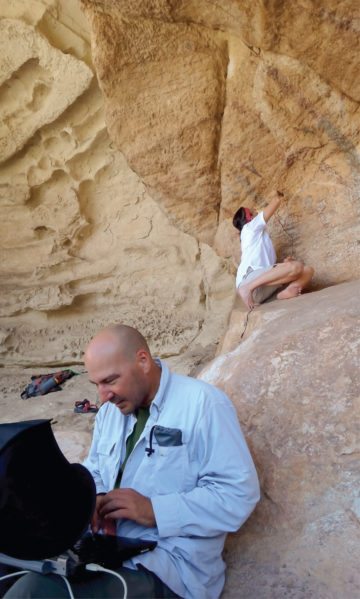
In other words, a culture’s creation narrative. If in fact that’s what it is, it may be the oldest such yet discovered in North America.
Last March, friends and I paddled the lower Pecos, some 67 miles from Pandale Crossing, north of Langtry, to a takeout just downstream of the Pecos River High Bridge, which carries Union Pacific freight trains and Amtrak’s Sunset Limited, and about 4 miles upstream of the White Shaman site.
Our first three nights on the river featured some of the heaviest weather I’ve ever experienced. Wind battered and broke our tents. Rain threatened to wash us out of the side canyons where we camped. Distant electrical storms provided panoramic pyrotechnics, and air-crackling strikes had us crouched and huddled in the lightning position, backs hunched to the sky. We slept in our clothes, shoes on, bug-out bags at the ready. We didn’t sleep well.
There are few things that conjure human vulnerability like exposure to extreme weather. And there are few things like exposure to conjure a sense of wonder. We saw jaggedly anthropomorphic figures inscribed in white sparks on dark and depthless skies. The mornings after, wet tracings spilled over the cliffsides. Over the course of millennia, the cliffs have become stained with parades of these vaguely humanoid shapes. Exposed on the Pecos, it’s easy to imagine where inspiration for cosmological drama might come from.
But the weather wasn’t all bad, and we had time for a side hike to a rock art shelter known as Piggy Panther, for the comically pudgy black-and-white feline that is its most distinctive figure. We also climbed to the flats above Lewis Canyon, where bedrock is inscribed with hundreds of petroglyphs describing abstract shapes, human figures and, according to some interpretations, star maps. It’s thought that these figures were created between 600 A.D. and 1600 — the last leg of a long march of Pecos peoples communicating across time.
The Lewis Canyon petroglyphs weren’t discovered until 1990, when a landowner, excavating to build a house, exposed the engraved bedrock. And the White Shaman mural wasn’t documented by modern people until 1957 (though an 1849 army expedition had recorded “rude Indian paintings on the rocks,” and a team from San Antonio’s Witte Museum had surveyed Lower Pecos rock art in 1931).
Since then, Pecos River-style rock art has been re-created by artists, documented by photographers and analyzed by archaeologists. It’s been gawked at by passing canoeists, graffitied by clueless teenagers and vandalized by antiquities collectors. Dozens, perhaps hundreds, of sites were drowned and lost when Amistad Reservoir filled after the construction of Amistad Dam in 1969. And Amistad continues to threaten the rock shelters, both by pushing sediment deposition upstream, which fills canyons with silt, and by increasing ambient humidity, which may encourage the buildup of a whitish mineral scale that obscures some of the paint. The rising riverbed, combined with overgrazing on the rootless plateaus above, contributes to an increased risk of flash floods. When the reservoir is full, the Rio Grande backs up in its channels and floods a site called Rattlesnake Canyon, where a 100-foot span of pictographs is sometimes submerged for weeks at a time.
The pictographs of the lower Pecos have lasted millennia in a tempestuous desert, surviving mostly in silence. Now that a code has been cracked, and they can begin to speak again, Boyd worries there may not be enough time to hear everything they have to say. So much has been lost already, and much remains at risk. But pessimism isn’t her strong suit, and time hasn’t run out yet. At Rattlesnake Canyon, for instance, she and the Shumla team are already finding that the paint follows the same order of application as at the White Shaman site: red over black; yellow over red; white over yellow.
And a distinctive figure — a red humanoid sporting antlers with black dots on the tines — appears over and over again. “We’ve got that same little guy, the guy with the antlers with the dots, he appears all over the place in the lower Pecos,” Boyd says. “So we started going to other sites to see if they did the same thing there, and it’s the same thing.”
At each site, the black dots are painted first. Later, the red antlers are painted around them.
“That starts telling you that there is a rule that governed the production of Pecos River-style rock art,” Boyd says. “This is an ongoing discovery. We are still making this discovery. It’s cool stuff. It just blows my mind.”
